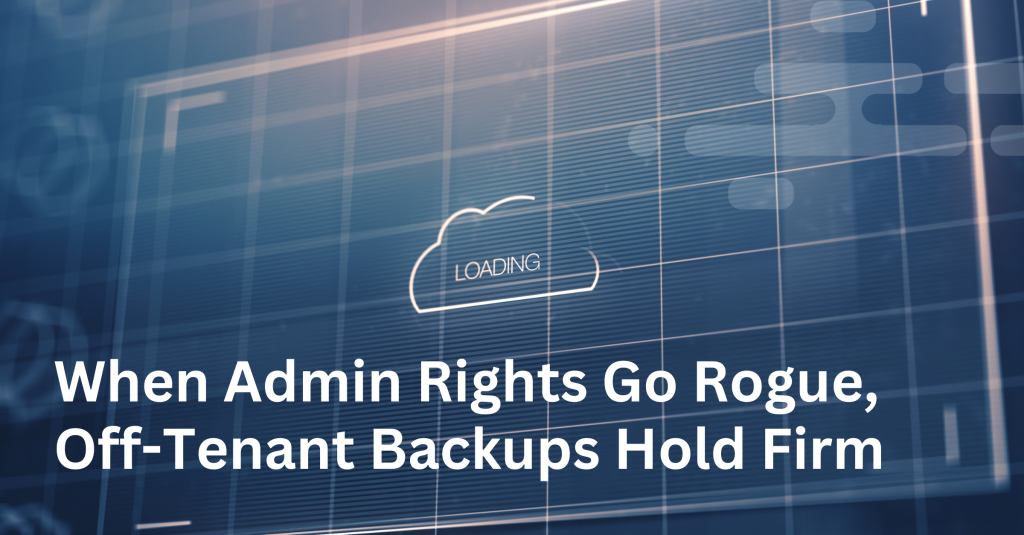Ransomware crews and credential thieves no longer stop at single servers. They aim straight for the console that runs your entire cloud estate. A recent threat brief found identity-driven attacks on public-cloud tenants rose by roughly one-third during the past year, significantly impacting Azure data safety.
When that console sits in Microsoft Azure, the blast radius covers every subscription, storage account, and virtual machine your organization owns. This article breaks down the danger of Azure tenant security breaches, shows why standard Azure features can fall short, and outlines a practical path – built on off-tenant Azure backup solutions – to keep your data available when attackers hold the keys.
Your Azure Tenant and the Shared-Responsibility Line
An Azure tenant is more than a billing container. It is the root of identity, policy, and role-based access for Microsoft 365 and every Azure subscription beneath it. Microsoft protects the data centers, the hypervisor stack, and the physical networks. You look after the tenant: accounts, multi-factor authentication (MFA), conditional-access rules, resource policies and, crucially, the data itself. When a threat actor gains global admin rights, that line of defence collapses.
Phished or Stolen Admin Credentials
Attackers still succeed with well-crafted phishing pages that mirror Microsoft’s sign-in flow. Once they capture a token, they skip passwords entirely. The result: Full administrative control, leading to data breaches, resource manipulation, or service disruption.
Token Reuse and Pass-the-Cookie
Attackers compromise a device, steal valid session tokens, and reuse them. This grants access without credentials, often for extended periods (e.g., up to 90 days), enabling silent lateral movement. Consequences: Prolonged, undetected access, data exfiltration, and potential for further network infiltration.
Guest-User Elevation
A recent design weakness shows how a guest invited to an Entra ID tenant can escalate privileges to Owner on a subscription without the real admin’s knowledge. When this happens, a low-privilege account can gain control over resources, risking data theft, resource damage, or unauthorized deployments.
Malicious Insider
Someone who already holds privileged roles may wipe or lock resources on the way out. This can lead to severe operational disruption, data loss, financial damage, and reputational harm due to abuse of trusted access.
Tenant-Wide Ransomware
Groups like Muddled Libra write automation that crawls Azure Resource Manager, snapshots every disk, then encrypts the live copies and the snapshots in one sweep. This can lead to complete lockout from workloads and data, including in-tenant backups, leading to major downtime and ransom demands.
When any of these paths succeed, all workloads—and the in-tenant backups—sit at the attacker’s mercy.
Why Built-In Azure Protection May Not Save You
Azure offers geo-redundant storage, disk snapshots, and Backup Vault immutability. These tools work for many everyday mishaps, yet they share three weak points in a tenant takeover:
- Same authority domain: The same global-admin role that deletes a production database can delete its vault and its retention lock.
- Replication of damage: Geo-replication mirrors the current block state. If ransomware scrambles the data, the service dutifully mirrors scrambled blocks to the secondary region.
- Billing lock-in during recovery: Pulling tens of terabytes from Azure during crisis hours creates eye-watering egress fees that delay or even cancel a recovery attempt.
Think of it like hiding your spare house key under the doormat. It helps when you forget your main key; it does nothing when an intruder already stands on the porch.
Off-Tenant Backups: A Separate Safety Net for Added Security
An off-tenant backup lives outside the identity and policy boundary of the production tenant. It might sit:
- in another public cloud provider
- in a managed backup cloud that uses service-provider credentials
- on-prem behind an offline gateway.
The storage target matters less than administrative separation. If the production tenant disappears, the backup copy stays intact. That said, for that backup copy to remain truly secure and provide reliable recovery when your primary Azure tenant is under duress, it needs more than just separation. We look at this next.
Technical Must-Haves
An effective off-tenant solution must be designed with specific technical capabilities to withstand the types of sophisticated attacks previously discussed. The following features are essential technical must-haves for such a system:
| Control | Why it matters |
|---|---|
| Independent identity store | Stops global-admin token reuse |
| Immutable retention lock | Blocks insider attempts to rewrite history |
| MFA on restore operations | Prevents unauthorised pull-back |
| Fast-recovery automation | Gets workloads online before downtime penalties pile up |
Audit Checklist: Five Questions You Should Ask
- Global-Admin Count: How many human users still hold un-scoped, permanent global-admin rights?
- MFA Coverage: Does every privileged user pass a second factor every time?
- Backup Isolation: Can someone in the production tenant browse or delete the off-tenant copy? This is key for Azure backup administrative separation.
- Recovery Objective: How long would a bare-metal restore of core systems take, end-to-end?
- Cost Ceiling: Do you know the worst-case egress bill today? If not, test it.
Make sure you can answer each question with evidence, not hope.
Final Thoughts
Microsoft keeps the lights on inside its data centers, but your tenant is your castle. Modern attackers climb the walls through stolen tokens, mis-set guest invites, and rushed configuration changes. Built-in Azure redundancy cannot help once someone wields global-admin rights. An independent, off-tenant backup closes that gap, giving you a clean launch pad when trouble strikes.
Revisit your data-protection plan this week. Confirm that the final copy lives where an attacker—and even an honest mistake—cannot reach it. When the next breach headline appears, you’ll know your data and your business can bounce back.





